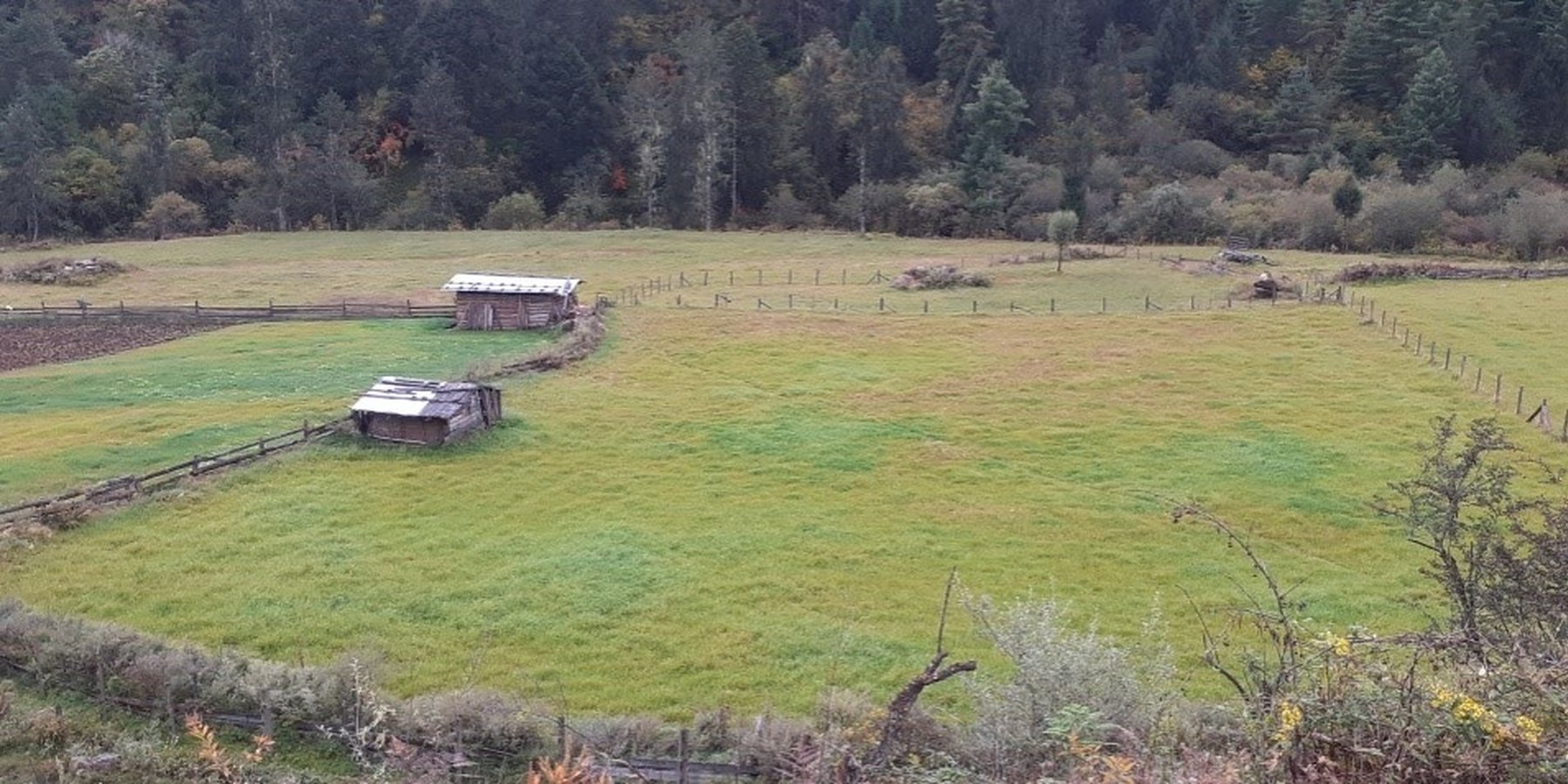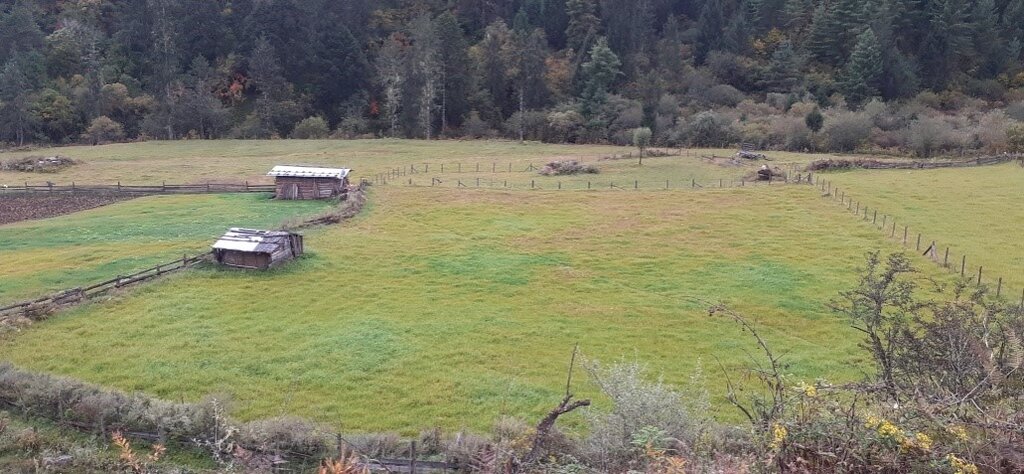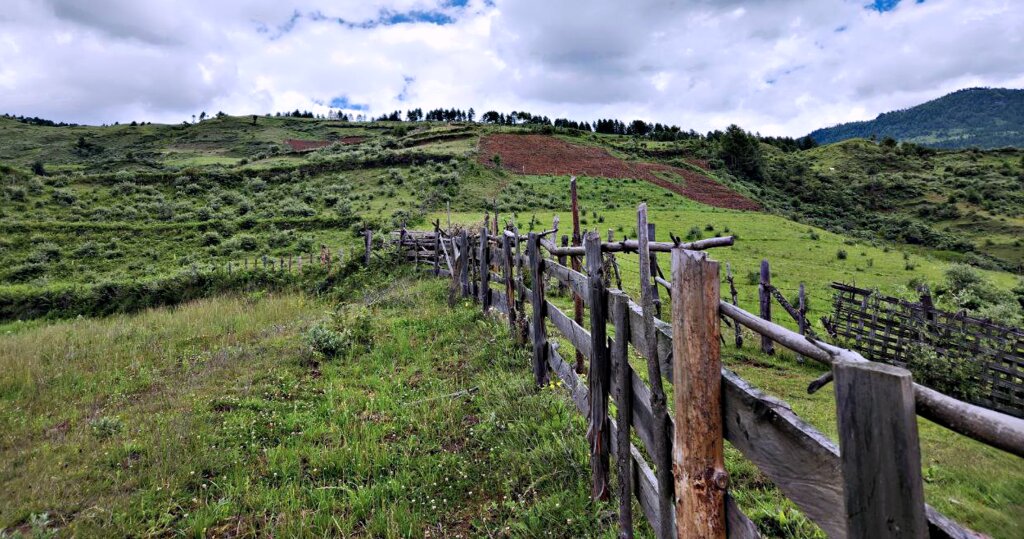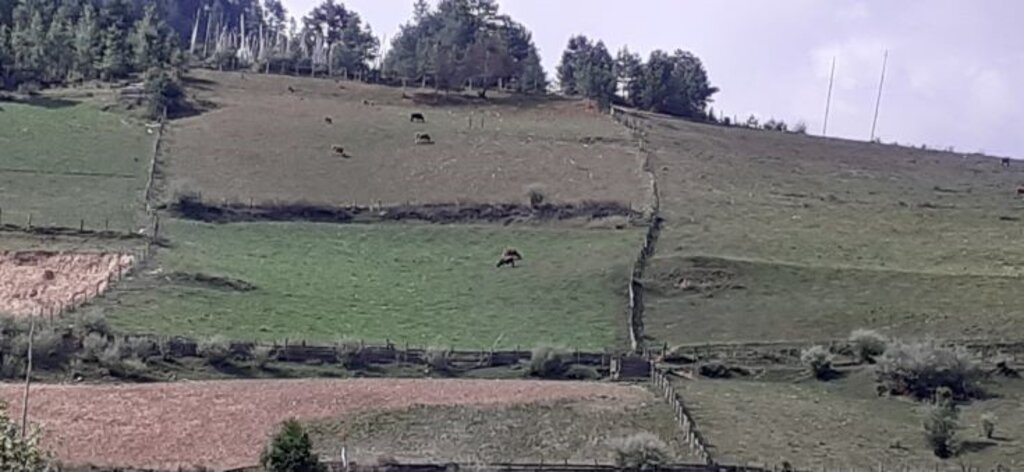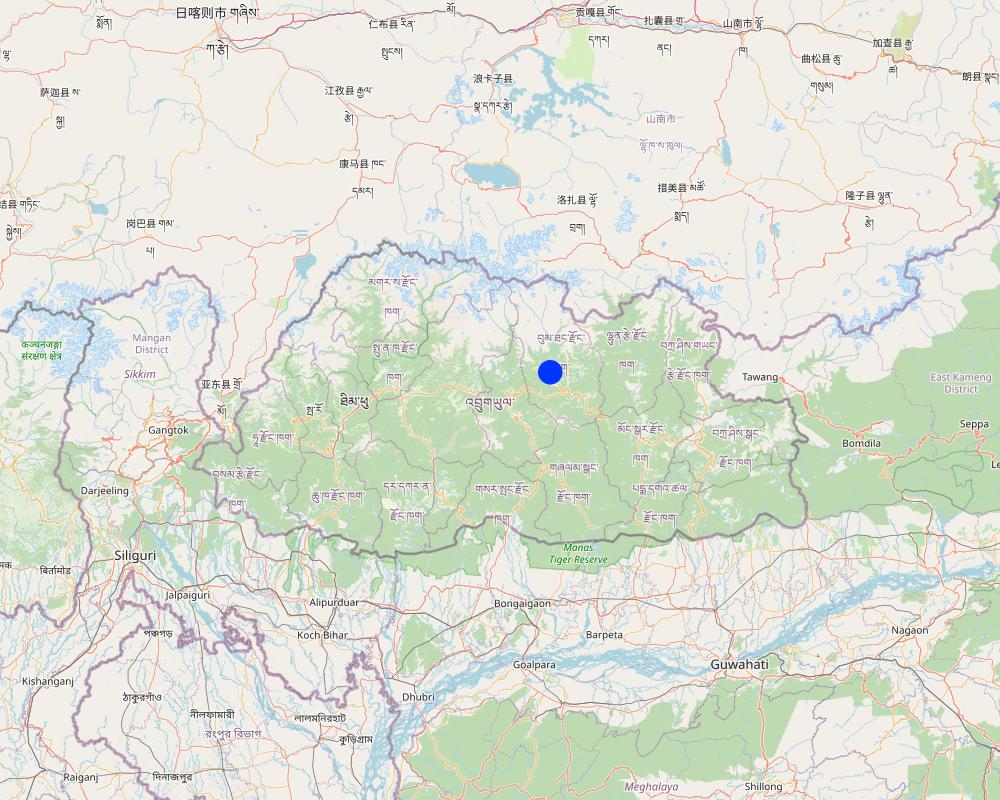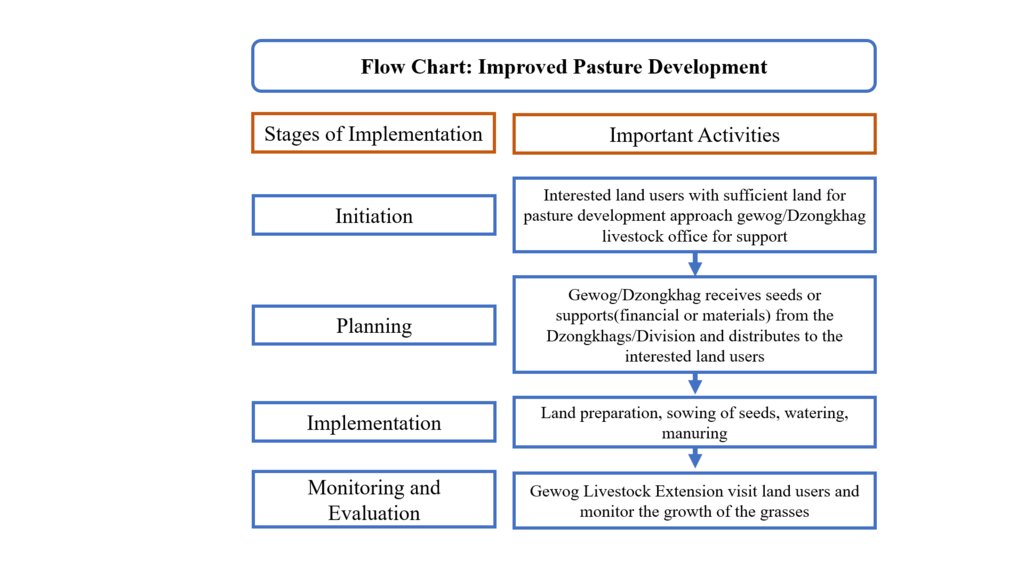Improved Pasture Development [不丹]
- 创建:
- 更新:
- 编制者: ONGPO LEPCHA
- 编辑者: Haka Drukpa
- 审查者: William Critchley, Rima Mekdaschi Studer
Tsamdro Gongphel (ཙྭ་འབྲོག་གོང་འཕེལ།)
approaches_6858 - 不丹
查看章节
全部展开 全部收起1. 一般信息
1.2 参与方法评估和文件编制的资源人员和机构的联系方式
关键资源人员
土地使用者:
Baleymo
Tangbi community
Tangbi, Choekhor Gewog (Block), Bumthang Dzongkhag (District), Bhutan
不丹
土地使用者:
Choden Sonam
+97517670437
Tangbi community
Tangbi, Choekhor, Bumthang, Bhutan
不丹
土地使用者:
Wangmo Phurpa
+97517951687
Tangbi community
Tangbi, Choekhor Gewog (Block), Bumthang Dzongkhag (District), Bhutan
不丹
有助于对方法进行记录/评估的项目名称(如相关)
Strengthening national-level institutional and professional capacities of country Parties towards enhanced UNCCD monitoring and reporting – GEF 7 EA Umbrella II (GEF 7 UNCCD Enabling Activities_Umbrella II)有助于对方法进行记录/评估的机构名称(如相关)
National Soil Services Centre, Department of Agriculture, Ministry of Agriculture & Livestock (NSSC) - 不丹1.3 关于使用通过WOCAT记录的数据的条件
(现场)数据是什么时候汇编的?:
19/07/2023
编制者和关键资源人员接受有关使用通过WOCAT记录数据的条件。:
是
2. SLM方法的描述
2.1 该方法的简要说明
The improved pasture development approach focuses on enhancing pasture productivity, which is managed sustainably for grazing. Livestock productivity depends greatly on improved pastures. It is very important to manage pastures to support the livelihoods of rural communities in Bhutan.
2.2 该方法的详细说明
该方法的详细说明:
The improved pasture development approach in Bhutan started at the beginning of the 5th Five Year Plan (1982-1987). Thangbi village, Bumthang, focuses on enhancing pastureland productivity and sustainability through the cultivation of improved varieties of grasses provided by the project. This initiative not only prevents land degradation and erosion but also enhances fertility by introducing leguminous species like clover. In temperate areas, improved pasture consists of a mixture of white clover, tall fescue, cocksfoot, and Italian ryegrass while in the subtropical areas, green leaf desmodium, molasses grass (Melinis sp.), ruzi grass (Brachiaria sp.), and stylo are grown.
Given the significant role livestock plays in the livelihood of Bhutanese communities, where productivity is strongly influenced by seasonal variations in fodder availability, improved pasture development addresses crucial objectives. These are: 1) Enhancing the resilience of pasture ecosystems to ensure continuous, high-quality fodder production; 2) Increasing forage availability and quality by promoting the cultivation of improved fodder species; and 3) Improving livestock productivity, directly impacting income generation through increased yields of animal products - especially of milk, cheese, and butter.
Implementation involves four stages: 1) Initial assessments of pasture conditions and land suitability, conducted by livestock extension officials; 2) Planning sessions involving officials from the Department of Livestock and land users; 3) Establishment of the identified areas for growing improved fodder species; and 4) Management of improved pasture plots by land users, accompanied by regular monitoring and evaluation to ensure effectiveness.
Key stakeholders in this approach include livestock extension agents and community members. Livestock extension agents act as a liaison between the community and the government. They also procure and distribute fodder grass seeds. Community members establish pastures in their farms, taking on responsibilities such as monitoring the water supply and caring for the grasses throughout their growing seasons.
Land users appreciate the approach because it ensures abundant fodder availability year-round, improving milk production through the cultivation of superior grass species, and reducing the workload associated with foraging in forests or tending grazing cows. However, concerns raised by land users include a reduction in cultivable land due to fodder grass cultivation and a lack of training regarding fodder management for those involved in the approach.
2.3 该方法的照片
2.5 采用该方法的国家/地区/地点
国家:
不丹
区域/州/省:
Bumthang Dzongkhag (District)
有关地点的进一步说明:
Thangbi Village, Choekhor Gewog (Block)
Map
×2.6 该方法的开始和终止日期
注明开始年份:
1980
注释:
The pasture grass seeds are provided to the community members annually free of cost and this approach is continuing until the present.
2.7 方法的类型
- 基于项目/方案
2.8 该方法的主要目的/目标
1) Enhance the resilience of pasture ecosystems: For countries like Bhutan, fodder production is largely affected by season and during off season, the productivity goes down drastically, leaving many land users in distress. Therefore, improved pasture development enables land users to continuously harvest quality fodder for their cows.
2) Increase forage availability and quality: The improved pasture development approach not only focuses on the production of fodder in quantity but also the quality by encouraging land users to grow improved varieties of fodder species.
3) Improve livestock productivity: Improving productivity is the primary objective as it directly connects to the quantity of animal produce like milk, cheese, butter, etc., that affects the income generated.
2.9 推动或妨碍实施本办法所适用的技术的条件
社会/文化/宗教规范和价值观
- 启动
Community members/land users shared the same social, cultural, and religious norms and values. Implementation of any project didn't have any issues.
财务资源和服务的可用性/可得性
- 启动
Community members/land users are provided with improved varieties of fodder grass for free based on the area of the land.
机构设置
- 启动
The improved pasture development has helped improve the livelihood of the community members.
了解SLM,获得技术支持
- 阻碍
The land users know that pasture development is directly related to SLM, however land users didn't receive any trainings on the improved pasture development through the approach.
工作量、人力资源可用性
- 启动
The workload has relatively decreased: In the past, community members had to go to the forest to either collect fodder or look after cow that graze on the grasses, but now pasture grass is readily available.
3. 相关利益相关者的参与和角色
3.1 该方法涉及的利益相关者及其职责
- 当地土地使用者/当地社区
Community members
Receive the fodder grass seeds and establish pasture lands in their registered lands. He/she also monitors the water requirement and takes care of the grasses throughout its growing seasons.
- Department of Livestock, Ministry of Agriculture and Livestock
Livestock extension agent
The livestock extension agent act as a bridge between the community and the governments. He/she handles the project at the grassroots level by meeting and discussing improved pasture development personally with the interested land users. He/she is responsible for procuring the seeds of fodder grasses and distributing them to the community members.
3.2 当地土地使用者/当地社区参与该方法的不同阶段
| 当地土地使用者/当地社区的参与 | 指定参与人员并描述活动 | |
|---|---|---|
| 启动/动机 | 被动 | Livestock extension agent upon consultation with research centers will carry out initial assessments of pasture conditions (which species of pasture grass species to be grown) and land suitability study. |
| 计划 | 互动 | The livestock extension agent and the community members decided on how to establish and implement the project. |
| 实施 | 自我动员 | In the initiation phase grass species are already identified and once planning is done. Land users will be provided seeds and they have to establish the pasture on their own. |
| 监测/评估 | 自我动员 | Monitoring of pasture field is normally done by the community members, and ocasionally it is monitored by the extension for scheduled reporting purpose. |
3.3 流程图(如可用)
具体说明:
The flow chart was created based on the information provided by the community members.
作者:
Ongpo Lepcha
3.4 有关SLM技术选择的决策
是否就技术的选择做出了决定?:
- Livestock extension agent
解释:
The livestock extension agent in consultation with relevant agencies procure and supply pasture grass seeds to interested farmers for pasture development.
- Consultation with research centers
4. 技术支持、能力建设和知识管理
4.1 能力建设/培训
是否为土地使用者/其他利益相关者提供培训?:
否
4.2 咨询服务
土地使用者有权使用咨询服务吗?:
是
指明是否提供了咨询服务:
- 在土地使用者的土地上
说明/注释:
Whenever community members require any sort of technical assistance or advisory services, Livestock Extension agent at their capacity provides the support. however, if higher intervention is required EA solicit supports from the dzongkhag, Central programs and the department of livestockand accordingly provide assistance.
4.3 机构强化(组织发展)
是否通过这种方法建立或加强了机构?:
- 是,少许
具体说明机构的强化或建立程度:
- 本地
说明机构、角色和职责、成员等。:
The livelihood of the community has been relatively better with the improved pasture development.
- Planting materials
提供进一步细节:
The extension agent would provide improved pasture grass seeds based on the availability of budget for seeds procurement.
4.4 监测和评估
监测和评估是该方法的一部分吗?:
是
注释:
Monitoring is mostly done by the community members.
若是,该文件是否用于监测和评估?:
否
4.5 研究
研究是该方法的一部分吗?
否
5. 融资和外部物质支持
5.1 该方法中SLM组成部分的年度预算
如果不知道准确的年度预算,请给出一个范围:
- 10,000-100,000
注释(例如主要的资助来源/主要捐助者):
The funding is mostly in terms of cost of the improved pasture grass varieties.
5.2 为土地使用者提供财政/物质支援
土地使用者是否获得实施该技术的财政/物质支持?:
否
5.3 对特定投入的补贴(包括劳动力)
- 无
5.4 信用
是否根据SLM活动的方法给予信用值?:
否
5.5 其它激励或手段
是否有其他激励措施或工具用于促进SLM技术的实施?:
否
6. 影响分析和结论性陈述
6.1 方法的影响
该方法是否帮助土地使用者实施和维护SLM技术?:
- 否
- 是,很少
- 是,中等
- 是,支持力度很大
No workshop or tainings were provided to the community members, however, they relied on their traditional knowledge on pasture land management.
该方法是否提高了土地使用者实施土地管理的知识和能力?:
- 否
- 是,很少
- 是,中等
- 是,支持力度很大
Community members relied on their traditional knowledge about pasture grass management
该方法是否建立/加强了机构、利益相关者之间的合作?:
- 否
- 是,很少
- 是,中等
- 是,支持力度很大
The livelihood of the community has relatively improved compared to the past.
该方法是否有助于社会和经济弱势群体?:
- 否
- 是,很少
- 是,中等
- 是,支持力度很大
All the households in the community irrespective of their background were provided with the pasture grass seeds.
该方法是否改善了性别平等并赋予女性权力?:
- 否
- 是,很少
- 是,中等
- 是,支持力度很大
All genders were equally encouraged to participate
该方法是否改善了粮食安全/改善了营养?:
- 否
- 是,很少
- 是,中等
- 是,支持力度很大
The cultivated land has decreased due to the improved pasture land
6.2 土地使用者实施SLM的主要动机
- 增加生产
The introduction of improved pasture grass, has helped improve dairy production in the community
- 降低灾害风险
Forest grazing is reduced, resulting to less incidence of human wildlife conflict (livestock depredation)
- 减少工作量
Since pasture grass is cultivated nearby the workload has decreased
6.3 方法活动的可持续性
土地使用者能否维持通过该方法实施的措施(无外部支持的情况下)?:
- 不确定
若否或不确定,请具体说明并予以注释:
The community member were unsure about its sustainability due to several factors such as rural urban migration and so on.
6.4 该方法的长处/优点
| 土地使用者眼中的长处/优势/机会 |
|---|
| Reduced workload |
| Fodder available in large amount |
| Higher milk production |
| 编制者或其他关键资源人员认为的长处/优势/机会 |
|---|
| Reduction of surface runoff |
| Increase fertility of the soil |
6.5 该方法的弱点/缺点以及克服它们的方法
| 土地使用者认为的弱点/缺点/风险 | 如何克服它们? |
|---|---|
| Reduction in cultivated land | |
| Land users have to depend on livestock officers for seeds | Training on seed production can be given to enhance their skills |
7. 参考和链接
7.1 方法/信息来源
- 实地考察、实地调查
One household
- 与土地使用者的访谈
Three individuals
7.2 参考可用出版物
标题、作者、年份、ISBN:
Marzban, S. & Valizadeh, N. (2020). Pasture Development: Fundamentals and Managerial Perspectives.
可以从哪里获得?成本如何?
https://www.researchgate.net/publication/339074876_Pasture_Development_Fundamentals_and_Managerial_Perspectives
7.3 链接到网络上可用的相关信息
标题/说明:
Improving the quality of pastures
URL:
https://business.qld.gov.au/industries/farms-fishing-forestry/agriculture/sustainable/graze/pasture/improve
标题/说明:
Pasture Development on Small Farms
URL:
https://farmstyle.com.au/news/pasture-development-small-farms
标题/说明:
Strategies for improving run down pastures
URL:
https://www.incitecpivotfertilisers.com.au/news-and-insights/agronomic-insights/pasture/strategies-for-improving-run-down-pastures
标题/说明:
Pasture Management: Effective Planning & Implementation
URL:
https://eos.com/blog/pasture-management/
链接和模块
全部展开 全部收起链接
无链接
模块
无模块


